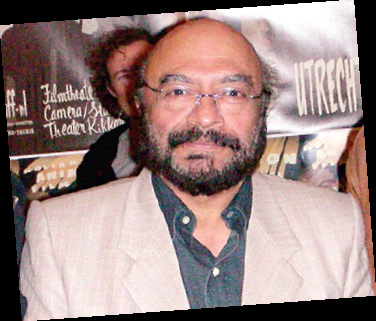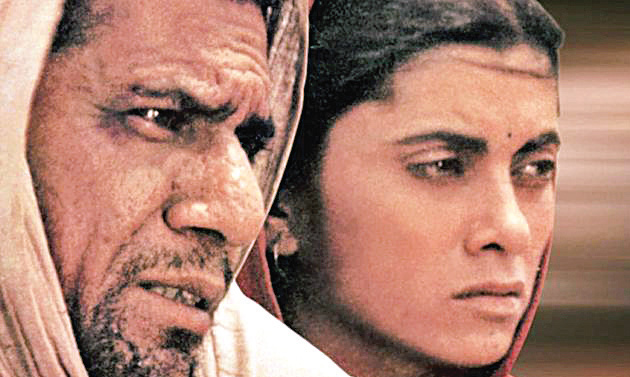Padma Shri awardee, filmmaker, cinematographer and one of the key figures of independent cinema in India, Govind Nihalani has just walked into Bangalore’s Ranga Shankara cafe and a young volunteer is asking him if she can get him coffee.
He asks, ‘What kind?’ She smiles nervously,”Filter?” He looks relieved and nods. Yes, he would very much like the typical Bengaluru coffee. Local coffee is not however the only thing he is familiar with. This is, after all, the city where he studied cinematography.
He passed out of Bengaluru’s Sri Jayachamarajendra polytechnic in 1962 and then decided he wanted to assist the master of darkness and light, cinematographer VK Murthy himself. In 1973, he also worked as a cinematographer for Girish Karnad’s film Kaadu.
In a conversation, Nihalani shares his memories of Murthy, Tamas, his wrenching drama about the tragedy of Partition, his unforgettable meeting with Indira Gandhi, censorship and the late Sadashiv Amrapurkar who made his Hindi film debut with Ardh Satya.
I asked Murthy, “When can I start?”
When I passed out with my diploma in 1962, Murthy was already a legend. His technique was very different from the glamour oriented work of Jaal Mistry and Fali Mistry though he could create glamour in his own way.
Watch Waheeda Rehman’s close ups in Pyaasa’s Jaane Kya Tune Kahi and Meena Kumari’s face in Na Jao Saiyyan in Sahib Bibi Aur Ghulam. Just magical. He was deeply influenced by European masterpieces and also used a bit of Hollywood’s framing techniques. And with Guru Dutt, he formed a tremendous partnership. I had made up my mind that I would assist him and so went to meet him in Mumbai. He was very nice and I asked him, ‘when can I start?” And he said, ‘Tonight? I am shooting for Pramod Chakravorti’s film Ziddi.” I had forgotten to ask him in which studio but found it somehow and we worked all night. And I knew, I had reached the right place.
Indira Gandhi foresaw the uproar over Tamas
I was working in Delhi as a second unit director and cameraman with the crew of Richard Attenborough’s Gandhi in 1981. My first film Aakrosh was being shown in the Panorama section of the International Film Festival Of India (IFFI) and we were told that Prime Minister Indira Gandhi wanted to meet the nominated directors.I remember being ushered to a room where I was supposed to talk to her for a few minutes. I had by then read Bhisham Sahni’s Tamas and I asked her if I wanted to make a film about a sensitive subject like Partition, would the government fund it?
She said immediately, “When do you want to start?” I said, “Depends on funding.”
She said, “It will depend on the political situation at the time.” I was struck by the perceptiveness of this woman. I had just mentioned the subject and she could anticipate its potential for controversy seven years before it was aired. In 2004, when I made Dev, post the Gujarat riots, I wanted to locate the story in the context of polarisation between two communities. I was lucky to get a Censor Board clearance but not before being asked to remove the word ‘Gujarat’ from a dialogue. I asked why and said, “Gaali toh nahin hai,” (it is not a cuss word) What had happened was a part of our history but then I did remove it because the rest of the film was left intact.
Though later, a friend (with right wing leanings) who had also been part of the Censor Board, said if the film had come before him for review, he would not have cleared it. So what can be made and shown also depends a lot on who is in power
Tamas can’t be made today
There are many filmmakers even now who can attempt a story like Tamas without shying away from uncomfortable facts but where will you show such a film, who will fund it and will it able to get Censor Board clearance?
Doordarshan commissioned it and aired it in 1988 but still it was accused of causing communal disharmony and a law suit was filed. Fortunately, a landmark Supreme Court verdict was given by Justices Bakhtawar Lentin and Sujata Manohar who overruled the interim order and permitted the screening. Today, private channels driven by revenue generation won’t show it. We are far more intolerant now than we were in 1988. People resort to violence easily now and if a work can endanger lives, I would rather not attempt it. Today the systems meant to protect citizens are failing them. But am still looking for characters who can take a stand and offer resistance.
Of films rooted in Indian stories
While working with Shyam Benegal, I came in touch with Pandit Satyadev Dubey. Shyam Babu, Karnad and Dubey would sit together and talk about politics, social issues, literature and it was very enlightening. I would work backstage with lights for Dubey’s plays and he would recommend this book or that author and that is how I began discovering compelling Indian stories.
I filmed Vijay Tendulkar’s scripts Ardh Satya and Aakrosh. Also Mahasweta Devi’s Hazaar Chaurasi Ki Ma, Mahesh Eklunchwar’s Party, which could not be released because I was told, ‘issme entertainment nahin hai.’
During that time, Shashi Kapoor, despite being a mainstream actor, supported the making of such stories (he produced Nihalani’s film Vijeta, scripted by Dubey). The aerial photography of Vijeta (1982) was a challenge as was the research that went into getting the Indian Air Force backdrop right. I still cringe when I see men in uniform in our films with their shirt buttons open. Today, actors want different subjects but not at the cost of commercial considerations.
We showed that another kind of cinema was possible
This was a time when we really felt, we were making a difference. We thought with every film, ‘kucch to hoga.’ But there was a huge backlash by mainstream cinema. Independent makers were accused of being boring, slow and depicting India in a bad light. The funding sources were questioned. Despite odds, we succeeded in showing the audience that another kind of cinema, without a big star, six songs, a comedy track or a happy ending, was possible. Our cinema, with its sensibility, created a space for different actors, stories and technique. Recently, I saw the digitally restored version of Junoon (1978) at the Mumbai Film Festival, where Imtiaz Ali had chosen it as his favourite film. I had got a national award for its cinematography and was surprised that so many people still remember it.
Sadashiv Amrapurkar had terrific timing
I was looking to cast the underworld don in Ardh Satya and Vijay Tendulkar recommended Sadashiv. I saw his comic play Hands Up and was floored. He had sharp, mischievous eyes. These were not ordinary eyes and looked right through you and I could see my villain in him. Later I realised that like Nilu Phule and Dr Shriram Lagu, he too was an actor with a social conscience. He was a part of many social groups, read a lot and even when he played Rama Shetty, he played him with great compassion. For him, characters were not types but human beings.








 with
with